 |
 |
 |
| |
Body Composition Changes after Initiation of Raltegravir or Protease Inhibitors.....
|
| |
| |
(1)peripheral & central fat & lean body mass increased similarly regardless of which of the 3 ART regimens they were taking.....(2)"regardless of the treatment regimen people who started with the high viral load (>100,000) gained double or triple the amount of fat" (HIV-1 RNA levels were associated with greater gains in VAT [>100,000])......(3) higher IL-6 (inflammation) was associated with greater gains in SAT......Higher HIV-1 RNA, IL-6 and D-dimer (inflammation), and lower CD4 were associated with greater gains in LBM (4) 16-18% of study individuals experienced limb fat loss of >10% & 6-8% had >20% limb fat loss with no differences between the 3 ART regimens. (ALL PRESENTATION SLIDES BELOW)
from Jules: of note baseline HIV viral load >100k was associated with large increases in belly fat & baseline inflammation was associated with increases in peripheral fat. We spent 20 years trying to understand & solve the lipodystrophy problem with little or no progress, my thought.
Reported by Jules Levin
CROI 2015 Feb 23-26, Seattle, WA
from Jules: Similar Increases in central fat seen in all 3 ART study arms - raltegravir, darunavir/r, and atazanavir/r, as the author Grace McComsey MD said this was a surprising outcome, presumably because I guess it was expected that perhaps raltegravir would not be associated with a similar increase in central (belly, VAT) fat. Higher pre-ART inflammatory markers were associated with increases in peripheral fat & lean body mass but not central fat.
After the presentation I went to the microphone & commented that the high viral load/increased fat & the inflammation association with increases in peripheral fat & LBM but not central fat - saying this suggests how the virus, HIV itself plays a role and that with 20 years of research into lipodystrophy we have not come to make great understanding perhaps little or no progress in understanding what is going on - in response Dr McComsey said: "It's amazing regardless of the regimen you look at the fat gains were so much more if you start with very high viral load and if you adjust for the inflammation markers viral load by itself remained associated with the greater gain" we have seen improvements regarding lipoatrophy with the change to new NRTis in recent years"... "we are not seeing none of it but we are seeing less"...."however for the hypertrophy its been really frustrating to do research on lipodystrophy because as you see a 30% gain in VAT after 2 years, thats really bad, in a relatively short duration of treatment, you are right the research lipodystrophy mainly the central fat needs to continue and needs to be maybe geared towards inflammation, other than looking at the drugs just themselves".....BMI increase of 3-3.5% in this study..."thats a lot"....."limb fat gains were about double with very high viral loads". Having said all this we know that before starting ART for the 1st time many patients are sick & may be skinny so the weight gain in the periphery & centrally is not all bad, to some degree its a return to health.
CROI: Fat and lean mass changes similar with raltegravir and PIs in ACTG analysis (02/27/15)
webcast:
http://www.croiwebcasts.org/console/player/25794?mediaType=slideVideo&

RESULTS:
- VAT (belly fat): lower baseline leptin, higher adiponectin and HIV-1 RNA levels were associated with greater gains in VAT; demographics, CD4 count and inflammatory markers were not.
- SAT (peripheral fat [lipoatrophy]): In addition to above factors, higher IL-6 was associated with greater gains in SAT.
- LBM (lean body mass): Higher HIV-1 RNA, IL-6 and D-dimer, and lower CD4 were associated with greater gains in LBM
All 3 study arms (raltegravir, darunavir/r, atazanavir/r) led to significant increases in limb fat from baseline to week 96 ranging from 11-20%, there were no statistically significant differences between arms (atazanavir 11%, raltegravir 20%, darunavir 14%); SAT (subcutaneous abdominal fat) increased as well & mirrored changes in limb fat with again no significant differences between ARTs: ATV/r 23%, RAL 25%, DRV/r 23%.
After 96 weeks of treatment limb fat loss of ≥ 10% occurred in 16-18% of subjects & ≥ 20% of limb fat loss occurred, with NO differences between ART regimens.
Central Fat: 2 measures were taken: trunk fat & VAT (visceral abdominal fat); Trunk fat- there were significant increases in trunk fat in all 3 arms after 96 weeks on treatment there were no significant differences between arms: ATV/r 16%, RAL 29%, DRV/r 21%. VAT Changes very similar about 30% increase in all 3 arms: ATV/r 31%, RAL 33%, DRV/r 29%. (see graphs below)
Of note baseline viral load ≥ 100,000 c/mL Dr Grace McComsey said - "regardless of the treatment regimen people who started with the high viral load >100,000) gained double or triple the amount of fat compared to patients who started ART with the lower viral load (<100,000)" (see chart below)
Lean Body Mass: again there were significant increases in all 3 study arms ranging from 1.2% to 2%, there was a trend to gain more with ATV/r vs DRV/r but that did not reach significance. (see graph below)

Body Composition Changes after Initiation of Raltegravir or Protease Inhibitors....the primary analyis for this study was to compare integrate inhibitor Raltegravir to protease inhibitors: Primary Analysis
-Change from baseline to Week 96 in peripheral fat (limb by DEXA and SAT by CT), central fat (trunk fat by DEXA and VAT by CT), lean mass
Despite the decline in the incidence of lipoatrophy with use of more mitochondria-friendly NRTIs, increased central adiposity continues to occur.
The pathogenesis of central adiposity remains unclear. Initially associated with PIs, however switching PIs to NNRTI or INSTI did not significantly improve central fat.
There has been no well-powered study has compared changes in body composition after initiation of PIs vs. integrate inhibitors.
CROI: Fat and lean mass changes similar with raltegravir and PIs in ACTG analysis (02/27/15)
webcast:
http://www.croiwebcasts.org/console/player/25794?mediaType=slideVideo&
The goal of this randomized prospective ACTG study was to compare body composition changes for individuals receiving raltegravir to darunavir/ and atazanavir/r along with TDF/FTC. Patients were relatively young with median age 35-36 ranging from 27 to 44 years and were treatment-naive. 90% were male, 41% white non-hispanic
The study followed these measurements including viral load changes:
At baseline and week 96
DXA scan (limb fat, trunk fat and lean mass)
CT abdomen (visceral and subcutaneous abdominal fat)
At baseline
Leptin, adiponectin, IL-6, hs-CRP, D-dimer, sCD14, sCD163





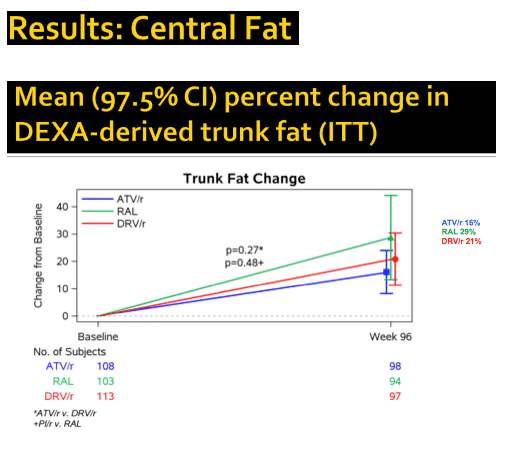
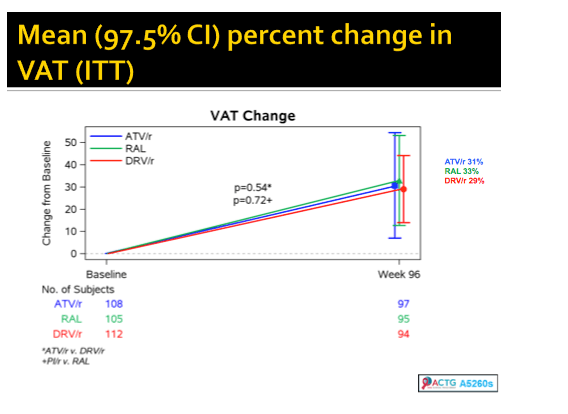
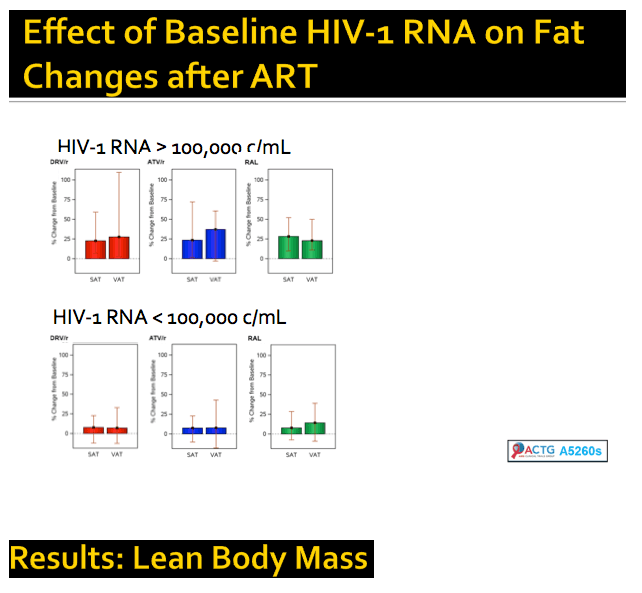
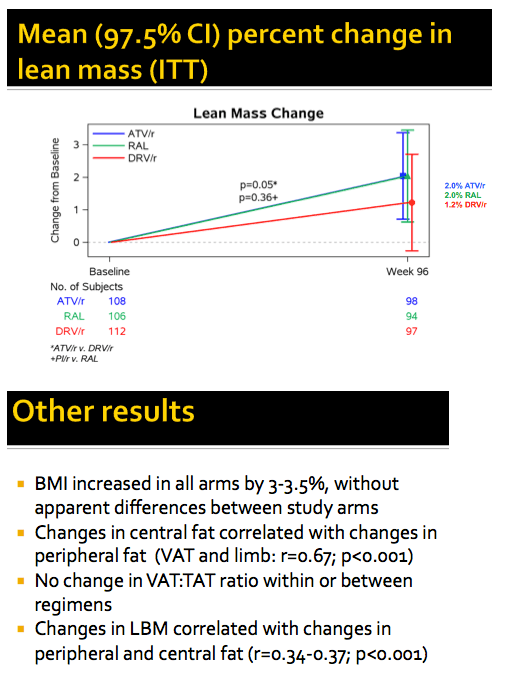
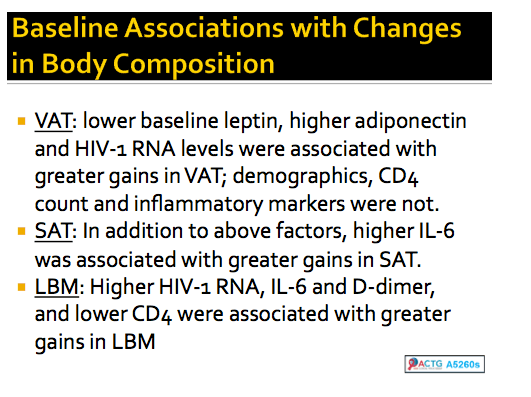
|
| |
|
 |
 |
|
|